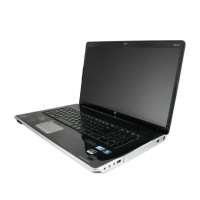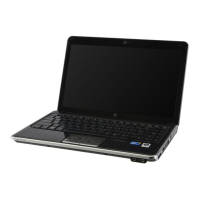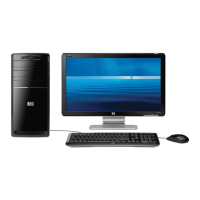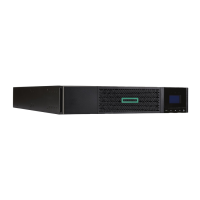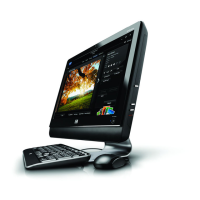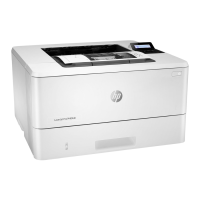Do you have a question about the HP Pavilion dm4 and is the answer not in the manual?
| Bus type | DMI |
|---|---|
| Stepping | C2 |
| Tjunction | 105 °C |
| Processor cache | 3 MB |
| Processor cores | 2 |
| System bus rate | 2.5 GT/s |
| Processor family | Intel® Core™ i5 |
| Processor series | Intel Core i5-400 Series |
| Processor socket | BGA 1288 |
| Processor threads | 4 |
| Processor codename | Arrandale |
| Processing Die size | 81 mm² |
| Processor frequency | 2.26 GHz |
| Processor cache type | Smart Cache |
| Processor lithography | 32 nm |
| Processor manufacturer | Intel |
| Processor front side bus | - MHz |
| PCI Express slots version | 2.0 |
| Processor boost frequency | 2.53 GHz |
| Processor operating modes | 64-bit |
| ECC supported by processor | No |
| PCI Express configurations | 1x16 |
| Thermal Design Power (TDP) | 35 W |
| CPU multiplier (bus/core ratio) | 17 |
| Maximum number of PCI Express lanes | 16 |
| Number of Processing Die Transistors | 382 M |
| Motherboard chipset | Intel® HM55 Express |
| Memory slots | 2x SO-DIMM |
| Internal memory | 3 GB |
| Memory clock speed | 1333 MHz |
| Internal memory type | DDR3-SDRAM |
| Maximum internal memory | 8 GB |
| Memory layout (slots x size) | 1 x 1 + 1 x 2 GB |
| HDD interface | SATA |
| Storage media | HDD |
| Optical drive type | DVD Super Multi |
| Card reader integrated | Yes |
| Total storage capacity | 500 GB |
| Compatible memory cards | Memory Stick (MS), MMC, MS PRO, SD, xD |
| Number of HDDs installed | 1 |
| Display diagonal | 14 \ |
| Display brightness | 200 cd/m² |
| Display resolution | 1366 x 768 pixels |
| Native aspect ratio | 16:9 |
| Contrast ratio (typical) | 500:1 |
| Display response rise/fall | 8 ms |
| Type | PC |
| LightScribe | - |
| Disc types supported | CD-R, CD-ROM, CD-RW, DVD+R, DVD+RW, DVD-R, DVD-RAM, DVD-ROM, DVD-RW |
| Ethernet interface type | Gigabit Ethernet |
| On-board graphics card model | Intel® HD Graphics |
| On-board graphics card base frequency | 500 MHz |
| On-board graphics card dynamic frequency (max) | 766 MHz |
| Speakers manufacturer | Altec Lansing |
| Video capturing speed | 24 fps |
| Front camera resolution | 640 x 480 pixels |
| Wi-Fi standards | 802.11b, 802.11g, Wi-Fi 4 (802.11n) |
| Cabling technology | 10/100/1000Base-T(X) |
| Networking features | Gigabit Ethernet, WLAN |
| Ethernet LAN data rates | 10, 100, 1000 Mbit/s |
| Charging port type | DC-in jack |
| Headphone connectivity | 3.5 mm |
| USB 2.0 ports quantity | 3 |
| USB 3.2 Gen 1 (3.1 Gen 1) Type-A ports quantity | 0 |
| Pointing device | Touchpad |
| Operating system installed | Windows 7 Home Premium |
| Form factor | Clamshell |
| Product type | Laptop |
| Country of origin | China |
| Battery life (max) | - h |
| Number of battery cells | 6 |
| AC adapter power | 65 W |
| Cable lock slot type | Kensington |
| Processor code | SLBPM |
| Processor ARK ID | 43537 |
| Processor package size | rPGA 37.5x 37.5, BGA 34x28 mm |
| Graphics & IMC lithography | 45 nm |
| Supported instruction sets | SSE4.1, SSE4.2 |
| Intel® Turbo Boost Technology | 1.0 |
| Operating altitude | -15 - 3048 m |
| Non-operating altitude | -15 - 12192 m |
| Storage temperature (T-T) | -20 - 60 °C |
| Operating temperature (T-T) | 5 - 35 °C |
| Storage relative humidity (H-H) | 5 - 95 % |
| Operating relative humidity (H-H) | 10 - 90 % |
| Depth | 228 mm |
|---|---|
| Width | 340.8 mm |
| Weight | 1990 g |
| Height (rear) | 32.2 mm |
| Height (front) | 25 mm |
| Depth (imperial) | 8.98 \ |
| Width (imperial) | 13.7 \ |
| Height (rear) (imperial) | 1.26 \ |
| Height (front) (imperial) | 0.98 \ |
Important warnings to prevent heat-related injuries and ensure safe operation.
Explains how to list installed hardware using Device Manager.
Identifies components on the top of the laptop.
Describes the status indicator lights on the laptop.
Locates and describes the power button and fingerprint reader.
Identifies special function keys and Windows keys on the keyboard.
Identifies ports and slots on the front of the laptop.
Identifies ports and connectors on the right side of the laptop.
Identifies ports and connectors on the left side of the laptop.
Identifies components related to the display assembly.
Identifies components on the bottom of the laptop.
Identifies the location of internal wireless antennas.
Identifies external hardware like power cord and battery.
Explains where to find the serial number label.
Lists and illustrates major internal computer components.
Lists and illustrates components of the display assembly.
Lists plastic parts such as covers and kits.
Lists optical and hard drives with specifications.
Lists various small parts like AC adapters and RTC batteries.
Lists components by spare part number.
Lists tools, service considerations, and plastic part handling for repairs.
Guidelines for safely managing cables and connectors during servicing.
Important considerations for handling hard drives and optical drives.
Procedures to prevent damage from static electricity.
Advice for safely packaging, transporting, and setting up workstations.
Details recommended grounding equipment and materials for ESD protection.
Explains the location and importance of the serial number.
Instructions for replacing the computer's rubber feet.
Step-by-step guide for handling the laptop battery.
Procedure for removing and inserting the SIM card.
Steps for replacing the computer's memory modules.
Guide for replacing the real-time clock battery.
Instructions for replacing the Wireless LAN module.
Instructions for replacing the Wireless WAN module.
Detailed steps for replacing the computer's hard drive.
Guide for replacing the optical drive.
Instructions for removing and installing the keyboard.
Steps for removing and reinstalling the top cover assembly.
Procedure for replacing the fingerprint reader board.
Guide for replacing the power button board.
Steps for removing and installing the entire display assembly.
Procedure for replacing the USB board.
Steps for replacing the power connector cable.
Instructions for replacing the Bluetooth module.
Guide for replacing the laptop's speaker assembly.
Detailed steps for replacing the computer's system board.
Instructions for replacing the fan and heat sink.
Steps for replacing the computer's processor.
How to access the BIOS/UEFI setup utility.
Explains navigation, selection, and basic operations within Setup Utility.
Procedures for saving or discarding changes and exiting Setup Utility.
Provides a summary of the available menus and options in Setup Utility.
General physical and power specifications for the computer.
Detailed technical specifications for the 14-inch display panel.
Technical details for various hard drive capacities.
Technical details for the DVD±RW SuperMulti Double-Layer Drive.
Information on viewing system resources via Windows Device Manager.
Instructions for creating a set of system recovery discs.
Guidance on regularly backing up data and system files.
Steps for performing backups using Windows features.
Explanation and procedure for creating and using system restore points.
How to revert the system to an earlier restore point.
Overview of recovery options and when to use Recovery Manager.
Steps to restore the system using created recovery discs.
Procedure for recovery using a built-in recovery partition.
Pin configuration for the headphone jack.
Pin configuration for the microphone jack.
Pinout for the VGA external monitor port.
Pin configuration for the RJ-45 network port.
Pin configuration for the HDMI port.
Pin configuration for USB ports.
Global requirements for power cord sets.
Power cord standards and agencies for specific countries.
Guidelines for safely disposing of and recycling the laptop battery.
Instructions for disassembling and recycling display components.
